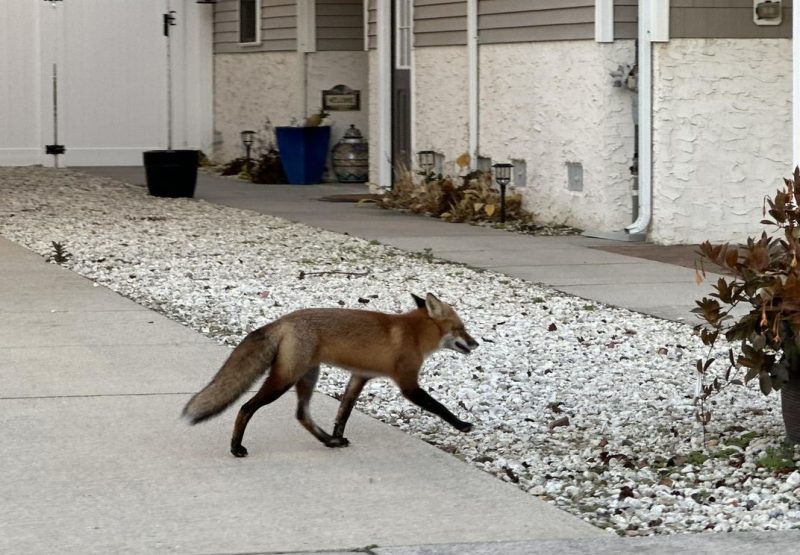A red fox believed to be the same one making the rounds in Sea Isle City for a few months is spotted at a home on 52nd Street. (Photo courtesy of Facebook forum SIC Chatter)
 By DONALD WITTKOWSKI
By DONALD WITTKOWSKI The red fox pays a visit to Annette Lombardo's home on 37th Street. (Photo courtesy of Annette Lombardo)
Samantha Collins, a research scientist and wildlife biologist at the Wetlands Institute in Stone Harbor, emphasized that no one should try to approach or feed the fox.
“Any wildlife species, even with a deer, it’s not a good idea to feed or habituate them. That’s usually when wildlife become an issue more,” Collins said.
“Even though he’s a local celebrity, people need to let him do his thing and be a wild animal,” she added about the Sea Isle fox.
Collins said that some foxes are wary of people and will make their homes in rural areas far away from humans. Others, though, are more at ease living closer to humans and in an urban environment.
“There are some fox that really like to be around neighborhoods, and this is probably one,” she said of Sea Isle’s vulpine visitor. “It’s an easy way for him to get his meals by hanging out in the neighborhoods.”
Among other things, foxes eat small animals such as rabbits, birds, bird chicks or bird eggs. They also eat plants, Collins said.
Foxes are part of the local ecosystem and a natural inhabitant of New Jersey’s barrier islands, according to the state Division of Fish and Wildlife.
The Wetlands Institute, a research center for the shore’s fragile ecosystem and wildlife, does not collect data on the local fox population. Collins explained that without any data, she can’t definitely say whether the fox population is on the rise this year at the shore, although there are encouraging signs.
“From our observations, they seem to be pretty well off. But there’s no data to back that up,” she said.
Lombardo has been visited by the red fox at her home on 37th Street. She hopes that his appearance in Sea Isle suggests that the local fox population is making a comeback ever since the animals were decimated a few years ago by mange, a skin disease caused by parasites.
“This is the first one I have seen in four years,” she said. “I didn’t know if I would ever see a fox again.”
The red fox pays a visit to Annette Lombardo's home on 37th Street. (Photo courtesy of Annette Lombardo)
Samantha Collins, a research scientist and wildlife biologist at the Wetlands Institute in Stone Harbor, emphasized that no one should try to approach or feed the fox.
“Any wildlife species, even with a deer, it’s not a good idea to feed or habituate them. That’s usually when wildlife become an issue more,” Collins said.
“Even though he’s a local celebrity, people need to let him do his thing and be a wild animal,” she added about the Sea Isle fox.
Collins said that some foxes are wary of people and will make their homes in rural areas far away from humans. Others, though, are more at ease living closer to humans and in an urban environment.
“There are some fox that really like to be around neighborhoods, and this is probably one,” she said of Sea Isle’s vulpine visitor. “It’s an easy way for him to get his meals by hanging out in the neighborhoods.”
Among other things, foxes eat small animals such as rabbits, birds, bird chicks or bird eggs. They also eat plants, Collins said.
Foxes are part of the local ecosystem and a natural inhabitant of New Jersey’s barrier islands, according to the state Division of Fish and Wildlife.
The Wetlands Institute, a research center for the shore’s fragile ecosystem and wildlife, does not collect data on the local fox population. Collins explained that without any data, she can’t definitely say whether the fox population is on the rise this year at the shore, although there are encouraging signs.
“From our observations, they seem to be pretty well off. But there’s no data to back that up,” she said.
Lombardo has been visited by the red fox at her home on 37th Street. She hopes that his appearance in Sea Isle suggests that the local fox population is making a comeback ever since the animals were decimated a few years ago by mange, a skin disease caused by parasites.
“This is the first one I have seen in four years,” she said. “I didn’t know if I would ever see a fox again.”